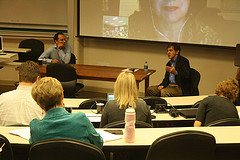Tom Watson was kind enough to share his presentation.
Author Archive
Tom Watson’s Presentation
September 19, 2009Integrating Social Media in Non-Profits Panel: Richard Waters
September 19, 2009Dr. Richard Waters is an assistant professor from North Carolina State University (NCSU). Before returning to academics, Waters was the Director of Communication and Development for statewide healthcare organization in California. His area of expertise is fundraising in regards to non-profits.
Dr. Waters has conducted a great deal of research in fundraising in non-profits specifically quantitative aspects of the healthcare industry. His findings show that there are some organizations that achieve great numbers with social media/technology, however there are also multiple organizations that don’t have great numbers (though people often disregard the failures).
Dr. Waters thinks that social media can be very helpful in terms of fundraising, but the face to face interaction is not going to be replaced. Though it is growing in numbers, Dr.Waters doesn’t believe in partaking in social media just because it is out there, instead we should think of a strategy.
Dr. Waters uses “Facebook Causes” as an example of using social media without strategy. The Washington Post showed that companies who used “Facebook Causes” had sub-par results. 73 percent of the “Facebook Causes” on Facebook generate zero dollars. Though a lot of organizations partake in the application–not a lot of them see results because they dive in without researching. Even though, people are giving more than ever, e-fundraising has shown signs of decline because strategy isn’t being thought about.
Moreover, according to Dr. Waters, social media should serve as complementary tool to non-profits. Currently, it is being utilized as an awareness tool. He references a study done with a graduate student in NCSU, which looks at Twitter. They found that two-way communication is not occurring as much as we think. They found that a lot of organizations are using Twitter to publicize something opposed to engagement.
Additionally, non-profits NEED to involve constituents personally. If non-profits don’t, then the messages they send to constituents become spam.
Connecting
September 19, 2009




Dan Greenfield on social media, Atlanta, and PR
September 14, 2009Get to know Dan Greenfield in 4 quick Q&As:
Q. Your session is called, “Is Social Media Transformational?” Is this, in your opinion, an important question to ask? What do you expect your session to do in terms of answering this question?
A. I think it’s a very important to ask the question – because beyond the hype and hyperbole, social media is in fact transforming the message, the means to distribute it and the organizations that deliver it. It decentralizes authority, redistributes power and redefines roles and responsibilities.
This session should define what social media is and its impact on the PR profession both in what we say and how we say it.
Q. You recently organized a PR/social media conference yourself. After that experience, what are your thoughts on the Atlanta PR community in terms of its knowledge, experience or use of social media?
A. Based on my experience organizing PR Camp Atlanta, I think Atlanta’s PR community like most communities in other cities is hungry for all things social media.
Social media is a moving target. They want to manage its impact on the way PR is sold, practiced and measured. They are realizing they are not alone in having many questions and few measurable solutions that they can take to their clients and bosses. They also realize that a generational divide exists between Generation Y and Generation X and Baby Boomers. Young PR professionals have a more intuitive, personal relationship to social media, but lack an understanding of how to communicate with an organizational voice. Their older counterparts may not how download apps on an iPhone or upload a video to Facebook, but they understand how social media fits into an overall communications strategy. Together they can teach other how to manage change and deliver better results to their clients.
Q. What are your favorite blogs to read? Do you read mostly PR blogs, mostly media/comm, or something else altogether?
A. Increasingly Twitter is replacing blogs as my source for opinions and information. Three years ago, I would tell anyone I knew to start a blog. Now I tell them to use Twitter – even though I love to blog. That being said, Mashable and ReadWriteWeb are essential blogs for anyone who wants to keep up with social media. They help keep track of the latest developments and provide useful advice.
Q. What’s your personal favorite social tool to use? How has social media benefited you personally or professionally?
A. Twitter and WordPress. I wouldn’t be speaking at the Connect 2009 conference without them. Enough said (and I still have 35 characters to spare).
*** Update after panel discussion of ‘Is Social
A Midwestern Coastie: Interview with Lt. Connie Braesch
September 11, 2009Lt. Connie Braesch is a 15+ year member of the United States Coast Guard and a Grady College alum. Originally from Omaha, Nebraska, she has been moved all over the country including Maine, Hawaii, Key West, and Alaska. Lt. Braesch will join us via Skype from Washington, D.C. where she is currently working at Coast Guard Headquarters as the Social Media Tactical Officer for Public Affairs. She will pair with Dr. John Tedesco to discuss the role of social media in the government.
When asked about the unique challenges the Coast Guard and the military at-large faces in their use of social media, she responded by saying the biggest challenge, outside of cybersecurity and operational security issues, is “providing the public an easily identifiable official source for information, which can be difficult to find in the decentralized and often puzzling online realm.” Braesch believes that “collaboration, search engine optimization (consistent tagging, identifiable URLs, regular content), and engagement are imperative.” To succeed, she cited it “requires communicators across the entire organization to be on the same page and driving towards the same goals.”
Braesch added that “This is not a simple task given the Coast Guard’s 11 mission areas and worldwide operations where every Guardian is a spokesperson for the service and (in the spirit of the social media tools) members, units and commands are encouraged to freely use social media to engage with the public. That’s a lot of cats to herd.”
Here are a few questions to get to know Lt. Braesch a little better:
Q: What are 3 facts (i.e. accomplishments, projects) about your career not found in your biography?
A: I am not sure these are so much as professional accomplishments as they are memories that I remember most about my career.1) For three years, in addition to my duties as the Sector Northern New England Command Center Chief, I coordinated and oversaw maritime Presidential security operations for President George W. Bush when he visited the Bush family summer home in Kennebunkport, Maine. I am honored to have a picture with his father, President George H. W. Bush, and to have been one of the few people to get a private/autographed photo with George W. Bush.
2) For nearly two years, during my first tour in the Coast Guard as a young 19-year old, I trained Coast Guard Recruits in physical fitness during bootcamp.
3) In my 15 and a half year career, I have relocated ten times and driven across the entire United States from coast-to-coast and corner-to-corner (not sure how best to say that beyond driving from duty station to duty station, I have also driven straight from New Jersey to California, Alaska to Key West (via the Alaska Marine Highway ferry), and Connecticut to Hawaii (well, I didn’t drive to Hawaii 🙂 but I drove to Los Angeles and shipped my car to Hawaii).
Q: If someone wrote a biography about you, what do you think the title should be?
A: A Midwesterner’s Coast Guard Career (sure, it’s not very original but that is why I am in the Coast Guard)Q: What (who) has been the biggest new media influence on your career?
A: I surely wouldn’t have the job I have now if it wasn’t for Dr. Karen Russell, Associate Professor at the University of Georgia. She introduced me to social media and challenged me to learn and adopt the communication tools.I will never forget one of my first days as a Mass Communication Graduate student… I was a business management undergrad, had not been in school for six years, and had been in the Coast Guard for 13 years when I found myself sitting in Dr. Russell’s Public Relations Foundations class. She started to talk about wikis, blogs, social media, Web 2.0, and many other terms I had never heard before. I even raised my hand and asked how to spell “wiki.” At that point, I knew I had a lot to learn and was in for a wild ride. I spent the next two years focusing on social media and challenging my use and application of the online tools. One of my favorite and most profound classes was Dr. Russell’s Word-of-Mouth Communication – a definite must for any PR student.
Q. What single piece of advice would you give to a PR educator? A PR pro?
I am neither an educator or a pro but I was a student and I am now new to the field of social media. So, my advice for a PR educator is that although I have heard educators say that they do not feel that they should show students how to use online tools, I feel that providing them a simple introduction to the basics will give them the familiarity and confidence to take the next step and the next and the next… The tools can be intimidating, but once you start you realize how simple they are. The anxiety and anticipated technological limitations all slip away.My advice for a PR pro is that for me, social media communications is all about teamwork. I think it is crucial to make sure social media communicators are either the subject matter experts or they have access to the subject matter experts to do fact checks and bounce ideas around. It also takes a team to collaborate, monitor, track, manage and engage in all the various tools that are used. It isn’t a one-person (or one-office) responsibility.
For more about Lt. Connie Braesch, read her blog My Coast Guard Career or follow her on Twitter @ConnieLea



 When non-profit organizations step into the social media world, they must first know their audience and have a particular goal in mind for reaching that audience, according to Sara Valkova of Emory Healthcare’s Web Marketing Team.
When non-profit organizations step into the social media world, they must first know their audience and have a particular goal in mind for reaching that audience, according to Sara Valkova of Emory Healthcare’s Web Marketing Team.



